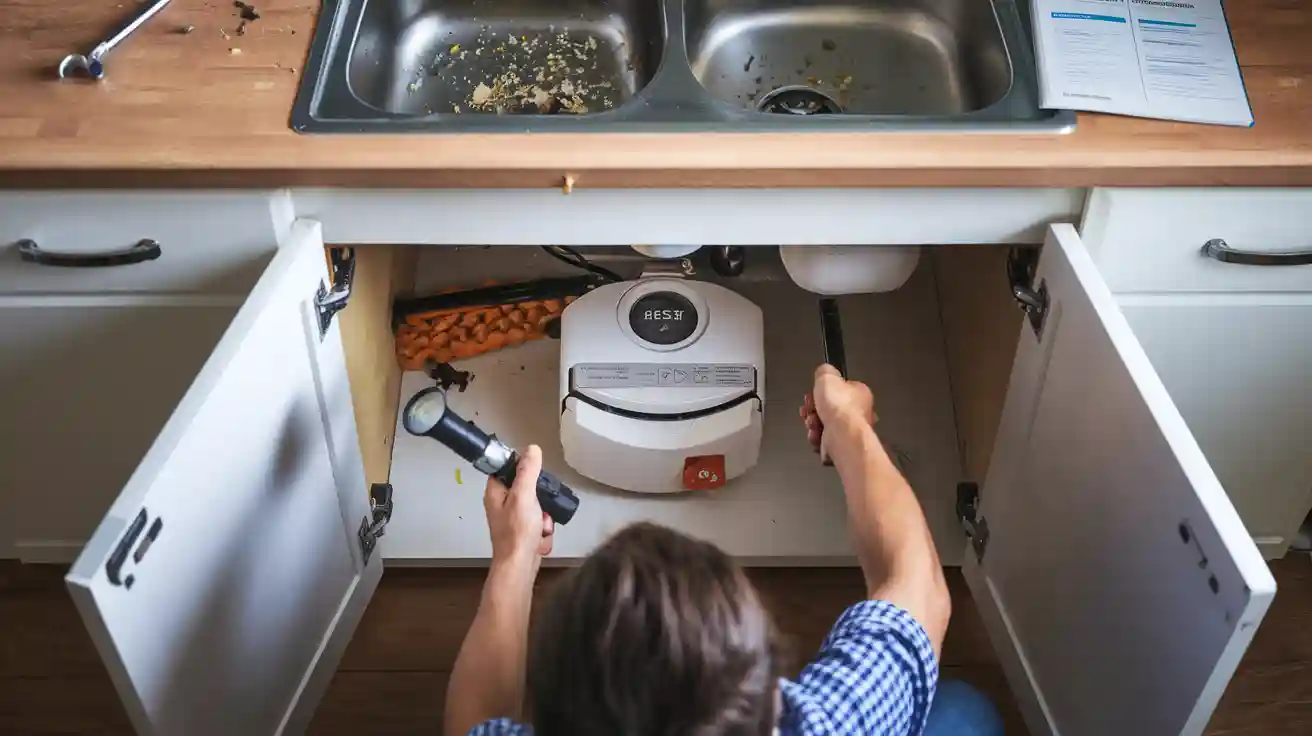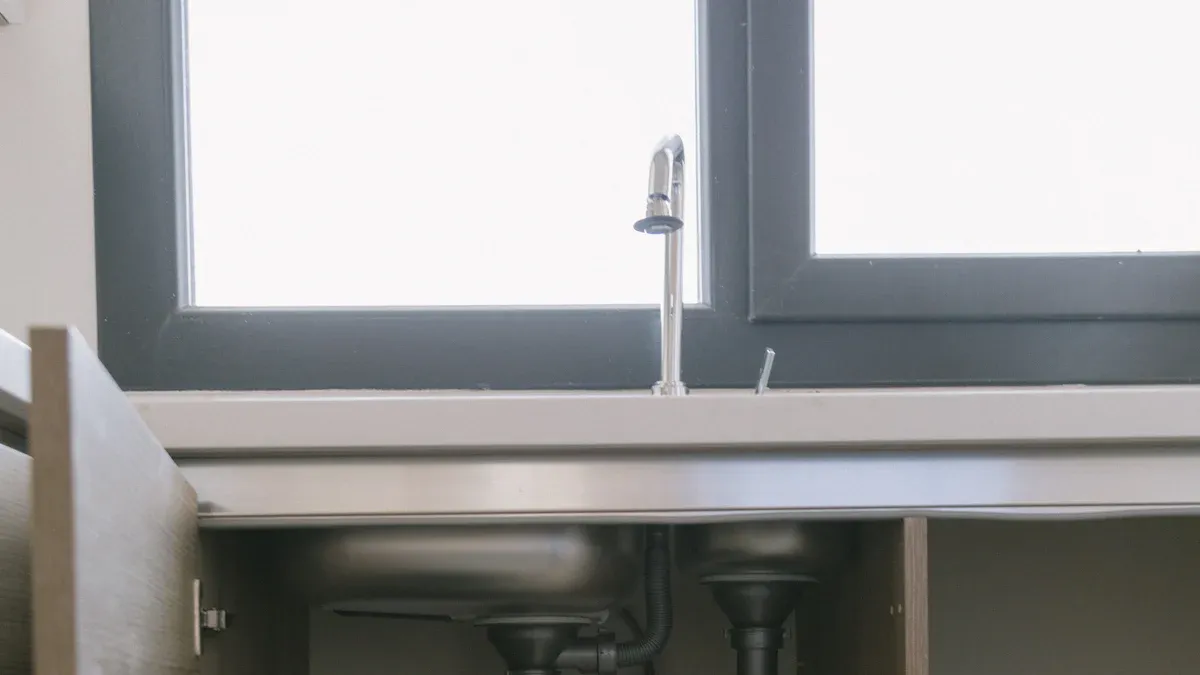
If your food disposal won’t turn on, you might feel stuck. You should check the power first, then press the reset button. Many garbage disposal stops working because of a jam or other common issues. Here are the most frequent problems you might face:
- Food particles or foreign objects can jam the blades.
- Power issues or tripped breakers stop the unit.
- Motors overheat or wear out after years of use.
- Some units leak or need repair when they get old.
When you troubleshoot the problem, always stay safe and never reach in with your hand.
Food Disposal Won’t Turn On: Safety and Power Checks

Unplugging and Staying Safe
When your food disposal won’t turn on, safety comes first. You should always unplug the garbage disposal or switch off the circuit breaker before you start any inspection. Water and electricity together can be dangerous, especially if the motor is burning out or the wiring is old. Never put your hands inside the disposal, even if it seems off. The blades inside are sharp and can cause serious injury. Use pliers or tongs to remove anything you see stuck inside. If you need to move the blades, grab an Allen wrench and insert it into the hex hole at the bottom. This lets you rotate the blades safely and clear jams.
Tip: Always keep your hands dry when working with electrical appliances. Wet hands increase the risk of electrical shock.
Here are the top safety steps recommended by appliance safety organizations:
- Disconnect power by unplugging the garbage disposal or switching off the circuit breaker.
- Never put your hands inside the disposal.
- Use tools like pliers or tongs to remove obstructions.
- Use an Allen wrench to manually rotate the blades if needed.
If you skip these steps, you risk electrical shock or cuts. Annual inspections help keep your garbage disposal safe and working well.
Checking Power Outlet, Wall Switch, and Circuit Breaker
Power supply issues are one of the most common reasons a garbage disposal stops working. If your food disposal won’t turn on, start by checking the outlet. Unplug the disposal and test the outlet with another device, like a lamp. If the outlet is dead, the circuit breaker may have tripped. Go to your electrical panel and flip the breaker off and on. Sometimes, repeated tripping means there is a deeper problem, like motor overload or faulty wiring.
Manufacturers suggest these steps:
- Identify if your garbage disposal plugs into an outlet or is hardwired.
- For plug-in models:
- Check the circuit breaker or fuse.
- Test the outlet and switch with another device.
- Flip the disposal’s wall switch on and off several times to check the electrical switch.
- If the test device works, but the disposal does not, you may need service.
- For hardwired disposals:
- Check the breaker or fuse.
- If still not working, the issue may be with the disposal or wiring.
Note: Signs of wiring problems include flickering lights or burning smells when you use the garbage disposal.
If you notice these signs, call a professional. Electrical problems can cause the disposal to stop working and may lead to more serious issues.
Pressing the Reset Button on Your Garbage Disposal
If your food disposal won’t turn on after checking the power, try pressing the reset button. You can find this button at the bottom of most garbage disposals. Pressing the reset button often fixes power problems caused by motor overload or a tripped internal breaker. Repair technicians say this step solves about 25% of power-related issues, especially if the unit has cooled down.
You should press the reset button if:
- The garbage disposal hums but does not grind.
- The motor stops working but makes a humming sound.
- The disposal has jammed or overheated.
Turn off the power before pressing the reset button. If you need to press the reset button often, your disposal may be getting old or have loose wiring. Frequent resets mean you should consider a replacement or call a professional.
Alert: Many homeowners forget to press the reset button after a problem. This is a common mistake and can keep your garbage disposal from working.
Inspecting Wiring and GFCI Breakers
If your food disposal won’t turn on after checking the outlet, switch, and reset button, inspect the wiring and GFCI breakers. Always turn off the power at the breaker or unplug the disposal before you look at any wires. Check your electrical panel for tripped breakers and flip them off and on. Find any GFCI outlets in your kitchen and press their reset buttons. Sometimes, a GFCI outlet fails but looks fine, so test it with another device.
Here are the steps for inspecting wiring and GFCI breakers:
- Turn off power at the breaker or unplug the disposal.
- Check the electrical panel for tripped breakers.
- Locate and reset any GFCI outlets.
- If breakers or GFCIs trip repeatedly, suspect wiring issues or a failing motor.
- Remove the wall switch cover and look for loose, disconnected, or burned wires.
- Replace the switch if it looks damaged.
- Use a multimeter to check for about 120 volts between black and white wires.
- If you feel unsure, call a professional electrician.
Warning: DIY repairs on garbage disposals can void your warranty and may cause safety risks. Professional repairs help keep your warranty and reduce long-term costs.
If you inspect the wiring and still find your garbage disposal not turning on, you may need expert help. Electrical problems can be tricky and dangerous, so don’t take chances.
Garbage Disposal Stops Working: Diagnosing and Fixing Common Problems
Clearing a Jammed Flywheel When Not Turning On
If your garbage disposal is not turning, you might have a jam. This happens when foreign objects or tough food scraps get stuck. First, unplug the unit or turn off the breaker. Never put your hand inside. Use tongs to pull out anything you see. Next, grab a hex wrench and insert it into the flywheel socket under the garbage disposal. Turn it back and forth until it moves freely. Remove the wrench, press the reset button, and try to run the disposal again. If the jam stays, you may need a repair from a professional.
What to Do if Garbage Disposal Hums but Won’t Spin
When your garbage disposal hums but doesn’t turn, the motor works but the blades can’t spin. This usually means a jammed impeller or a clog. Cut the power first. Shine a flashlight inside and check for any clog or stuck debris. Use a hex wrench to turn the flywheel. If the blades move, you’ve cleared the jam. Press the reset button and test the disposal. If the garbage disposal hums but doesn’t turn after this, you might have an overheating motor or other malfunctions. Call for repair if the problem continues.
Garbage Disposal Doesn’t Drain: Addressing Drainage Problems
A garbage disposal doesn’t drain when food, grease, or starchy foods block the drain. You might notice water backing up or draining slowly. Turn off the power before you start. Use a plunger to loosen the clog. Pour baking soda and vinegar down the drain to help break up debris. If the drain stays blocked, detach the drain pipe and clean it out. Always check for any clog in the pipe or disposal. Avoid putting grease, pasta, or coffee grounds down the drain to prevent future issues.
Checking for Leaks and Persistent Issues
Leaks are common issues with garbage disposals. You might see water under the sink or dripping from the unit. To find the leak, unplug the disposal and dry the area. Fill the sink and watch for leaks around the flange, drain pipe, or dishwasher hose. Tighten any loose connections. Replace worn gaskets or seals if needed. If you spot cracks or if leaks keep coming back, you may need a repair or even a new garbage disposal. Persistent problems like frequent jams, loud noises, or electrical issues mean it’s time to call a professional.
You can solve most garbage disposal issues by following these steps.
- Always unplug your garbage disposal before you check for problems.
- Never reach into the drain with your hand.
- Run cold water before and after using the disposal to keep the drain clear.
- Clean your garbage disposal with ice cubes and citrus peels every few weeks.
- Call a professional if you hear strange noises, see leaks, or if the drain stays clogged.
Regular maintenance helps your garbage disposal last up to 15 years and keeps your drain working smoothly.
FAQ
Why does my garbage disposal smell bad?
You might have food stuck inside. Try grinding ice cubes and citrus peels. This helps clean the blades and freshen the smell. 🍋
Can I sharpen the blades in my garbage disposal?
You cannot sharpen the blades. Grinding ice cubes helps clean them, but it does not make them sharper. The disposal breaks food apart, not slice it.
What should I never put in my garbage disposal?
Never put grease, bones, coffee grounds, or fibrous foods like celery in your disposal. These items can cause clogs or damage the unit.


